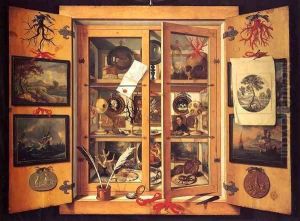Domenico Remps Paintings
Domenico Remps, an artist whose work has intrigued art historians and collectors alike, was born in 1620. Although there is limited information about his early life, it is believed that he was Italian, a detail that is reflected in the style and subjects of his work. Remps is primarily known for his cabinet of curiosities paintings, a genre that was popular in the 17th century, reflecting the period's growing interest in collecting and documenting the natural world and archaeological finds. These cabinets were essentially the precursors to modern museums, and paintings of them served as a catalog of the collector's items as well as a showcase of the artist's skill in rendering diverse textures and objects.
Domenico Remps's most famous work is a painting of a cabinet of curiosities, which is celebrated for its meticulous detail and the variety of objects it depicts, from natural specimens to scientific instruments. This painting, which is often cited as an exemplary work of the genre, demonstrates Remps's mastery in creating a realistic and captivating representation of the collected items of his era. His ability to paint different materials, from the sheen of metals and glass to the duller textures of stones and wood, showcases his exceptional skill and attention to detail.
Despite the fascination with his work, little is documented about Remps's life, including his training and whether he traveled extensively, which was common for artists of his time seeking inspiration and patronage. His death in 1699 marked the end of a career that, while not widely documented, has left a lasting impact on the art world. Domenico Remps's contributions to the cabinet of curiosities genre have provided valuable insights into the collecting practices and aesthetic values of the 17th century, making his work a subject of study for art historians interested in the period. Through his paintings, Remps offers a window into the curiosity and sense of wonder that defined his era, making him a notable figure in the history of art.
